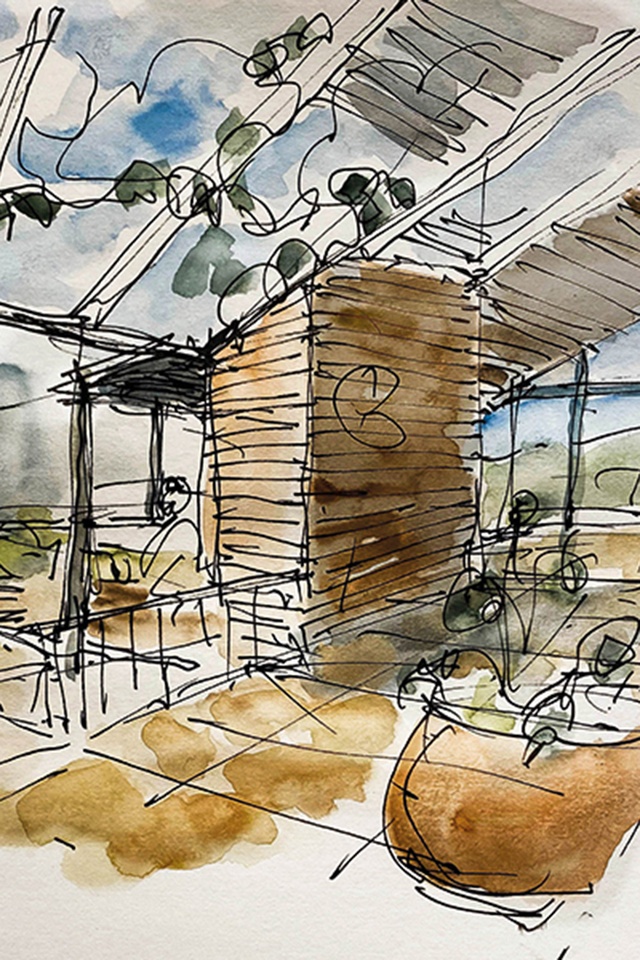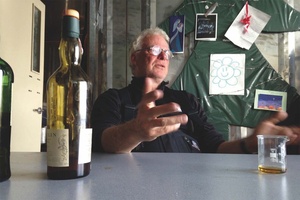Some ideas about ideas
We have a commission, a new commission: a cause for some small celebration in these times of uncertainty. It is a very small commission that may lead to something larger but, at the moment, our clients have limited expectations of us – just some illustrations of a possible building.
It is hoped the images will help galvanise the client group, focusing their discussions and gaining agreement about the specifics of a brief. It is hoped that we might make some drawings that could be used for fund-raising, too. This is not unusual; the power of a drawing to make manifest a group’s hopes and dreams can be a potent rallying point, and something we are occasionally asked to do.
It’s not as if there is a reservoir of forms and shapes lying in wait for a client to come through the door. It is, instead, an inexorable grasping for ideas, influences and possibilities, scraps of ideas gathered, debated and sketched. Each is examined for fit into a nascent conceptual armature, itself only partially revealed. The ideas are elusive, delicate little things, flickering in and out of focus, falling easy prey to doubt and uncertainty.
I don’t think I am alone in this, though, in the past, I have seen mates sitting across desks from me, roaring out schemes that seemed to gush from their imaginations fully formed, needing only client affirmation for them to head off into documentation. And haven’t we all sat in darkened halls as the stars of our profession roll out schemes with an intimidating, certain, linearity of thought? No, it’s not like that for me.
“And haven’t we all sat in darkened halls as the stars of our profession roll out schemes with an intimidating, certain, linearity of thought? No, it’s not like that for me.”
I think we work collaboratively in the studio, though I acknowledge it may not seem that way to those caught up in the maelstrom around me. I want to draw in those who will be involved in a project, knowing it is wise to expose the earliest traces of a scheme to the thinking of others. It is good, too, to capture the energy of those who will be involved if the idea takes hold and those uncertain staccato scratchings evolve into the certainties of developed design. Yet, therein lies a trap. Those early marks can be as fragile as early-morning mist and I feel the project is at risk, as if a fledgling idea might be crushed in the cacophony of graciously offered suggestions by those around me. I think this is a very difficult time for others. I profess openness to ideas, suggesting an enthusiasm for alternate stratagems, yet my brow invariably furrows as I see the implications of an arid familiar line of enquiry.
“Those early marks can be as fragile as early-morning mist and I feel the project is at risk, as if a fledgling idea might be crushed in the cacophony of graciously offered suggestions by those around me.”
The world of architecture schools is at some remove from this. It is a bit of a shock to come from a world of balancing time-driven customer expectations of utility and cost with those of code, climate and topography, and enter the gentle halls of learning. Reviewing student schemes, it often seems as if everything is negotiable, only the basic laws of physics seem not to be in play and, at times, they too seem to be malleable. Freed from the dictates of those paying fees and the lumbering apparatus of project teams, the programme becomes the brief, and our critique has an hermetic, self-referential quality to it.

Let me quickly say that I would have it no other way. There is a lifetime ahead, we hope, of meeting the seemingly capricious whims of clients and building inspectors, yet how hard it is for the working architect to elbow aside project demands and make some time for speculation, doodling and ruminating in the manner of students. The translation from glimpsed idea to digital simulacrum is a laborious one, requiring both time and mental ‘wavelength’ for even the most adroit of users. As a result, the user becomes vested in the laboured exposition of an early proposition, ensnared by the wonderful imagery delivered up. Consequently, an idea is sometimes settled too quickly, the attraction of a half-pie-decent scheme prevailing over the uncertain outcome of yet more iterative design development. This is a phenomenon of both school and working studio, particularly so where computers are employed in design.
Of course, these are gross generalisations, as a visit to an architecture school near semester’s end will attest. There, one will see extraordinary illustrations of schemes that are always interesting and occasionally breathtaking in the breadth of their development and resolution. Nor is my critique of the dash to digital the grumpy commentary of an elderly curmudgeon damned to an analogue life. Rather, I count myself as a survivor, a rehabilitated user of the mouse: someone for whom time in the ‘big room’ beyond the monitor was once a place of uncertainty, doubt and confusion.
In part three of Gulliver’s Travels, ‘A Voyage to Laputa … and Japan’, Jonathan Swift lampooned the architecture school, describing the inhabitants of the aerial island of Laputa as being “unable to construct well-designed clothing or buildings, as they despise practical geometry as vulgar and mechanick”. He describes experiments in building from the roof down, a process inhibited by the constructors’ undue faith in mathematics. Swift also describes the island king’s means to bring a recalcitrant village to heel by the careful placement of the floating island overhead, thus denying the village sunlight and rainfall. We are fast approaching a time where we will require intervention of this magnitude and it is likely that it is through just such exploration of the wilfully wild and fanciful that the best hope of coping with the apocalyptic challenges ahead will be found.
“We are fast approaching a time where we will require intervention of this magnitude and …through just such exploration of the wilfully wild and fanciful that the best hope of coping with the apocalyptic challenges ahead will be found.”
A recent New Yorker article by Sam Knight describes a more terrestrial but no less adventurous experiment by Scandinavian architect Pavels Hedström. Having studied, eulogised and visited Japanese Metabolist architecture, then survived a stint working at Herzog & de Meuron, Hedström arrived at the view that “most architecture separates us from nature”. The article goes on to describe one of his more recent projects in which a suit, not unlike a diver’s dry suit, provides the growing conditions for a large number of mealworms packed around the wearer’s body, consuming plastic waste, and who are then, in turn, cooked and consumed by the wearer.

I don’t think our studio’s current high-speed commission will allow the intensity of a better student’s enquiry nor provoke Hedström’s commitment to being immersed in slithering worms in the cause of global resilience. If nothing else, Hedström’s proclivity for burnt orange in the fabrication of his mealworm suits would find little favour in our studio, where clothing, with few exceptions, tends more to Greek funereal black. For all that, forgoing a suit full of styrene-munching worms does not absolve us from our responsibilities to the planet, and speculative projects like that on which we have embarked offer strong opportunities to negotiate the path between survival of the species, the development of architectural propositions and the well-being of the studio whānau.










